Guitar Head Amplifiers Market Research, 2031
The global guitar head amplifiers market was valued at $129.5 million in 2021, and is projected to reach $207.6 million by 2031, growing at a CAGR of 5% from 2022 to 2031.
An acoustic or electric guitar's audio signal is taken by a guitar amplifier, which amplifies, or increases, the input to make it louder with less distortion. A speaker or speakers are typically included in an amplifier, which is the actual device that alters the signal. Like a lot of electronic devices from the 1940s and 1950s, the first guitar amplifiers were powered by vacuum tubes. Many musicians favored the distinctive sound and quality of a tube guitar amplifier even when electrical technology replaced them with transistors. As a result, there is still a significant market for reproduction and vintage amplifiers. They are more expensive and might be hard to fix, but they have a sweet tone and natural feedback loops.
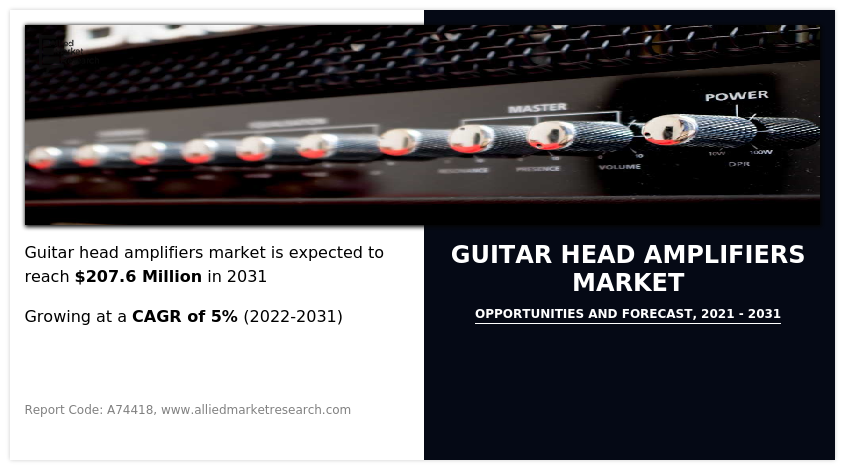
The transistor or solid-state type of guitar amplifier is another type. To boost the unamplified signal for the secondary power amplifier in an electric guitar, the amplifier needs to have a preamp. After that, its force is sufficient to vibrate the speaker and become audible. In tube amps, effects like distortion and feedback can be strictly controlled instead of developing organically. For a clearer sound, those effects can also be easily removed. Strong state guitar amps seldom need fixes. In a detailed way, copper wire is wrapped around a permanent magnet to create the pickup. On some guitar pickups, you'll have the option to see attractive posts that are normally situated under each string. The magnetic field is focused by the poles. Now, when a string is plucked, the string will vibrate, causing a change in the permanent magnet's magnetic field. Finally, a small current will be generated in the pickup's coil by the moving magnetic field.
Most of the time, permanent magnets like ferrite or alnico are used to make pickups. Humbuckers work the same way, but they have two coils instead of one. The pickup's coils induct a relatively small current, but this is where the amplifier comes into play. When this current or signal is amplified with an amplifier, it produces something that can be heard and played. On the input, the circuit will amplify the signal twenty or even fifty times as it enters the amplifier. After that, the amplified signal will be sent to the speakers before the output transistors add current to it. The guitar will sound different and be something you can hear because the transistor circuits can take a small voltage on the input and turn it into a larger voltage on the output.
Considering volume, adaptability, portability, and how it sounds with a particular guitar when choosing a guitar amplifier is important. Bringing the guitars to the store can put them through their paces in every possible setting. A guitarist generally looks for sound effects like reverb, delay, or echo, balanced sound between bass and treble, and clean amplification with a responsive equalizer. One should be able to practice solo, jam with other amplified instruments, and perform in larger venues with it. Although the power amp "head" and speaker can be purchased separately from guitar amplifiers, they typically come together as a "combo." The size, type of wood, and whether the back is open or closed all have an impact on the cabinet's sound. For instance, cabinets with closed backs produce more bass. Guitarists can construct their combo guitar amplifier if they know exactly what they want.
Segment Overview
The guitar head amplifiers market is segmented into Type, Sales Channel, and Application.
By type, the market is divided into head amplifiers and combo amplifiers. In terms of market segmentation by type, the market was dominated by combo amplifiers in 2021. The combo amplifiers segment is also expected to witness a higher growth rate during the forecast period. There is a growing demand for portable combo amplifiers as more guitarists travel to gigs and perform live.
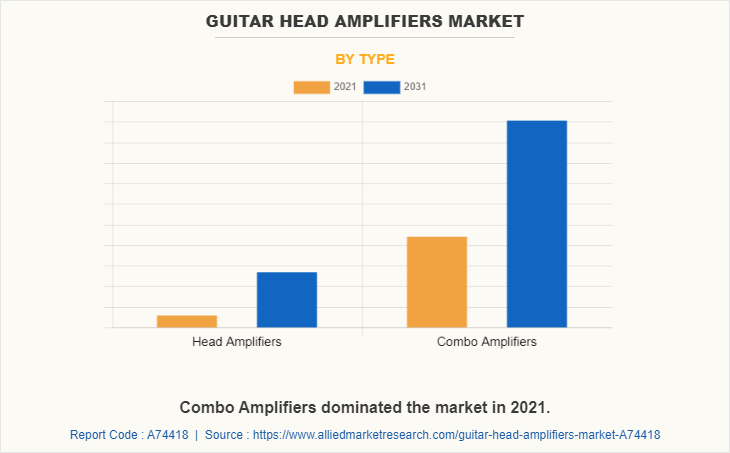
The sales channel segment is divided into online and offline. In terms of market segmentation by sales channel, the market was dominated by the offline segment in 2021, whereas the online segment is also expected to witness a higher growth rate during the forecast period. The growing importance of specialized music stores that cater to a specific type of musician or music genre is one notable trend behind the growth of the offline sales of guitar amplifiers.
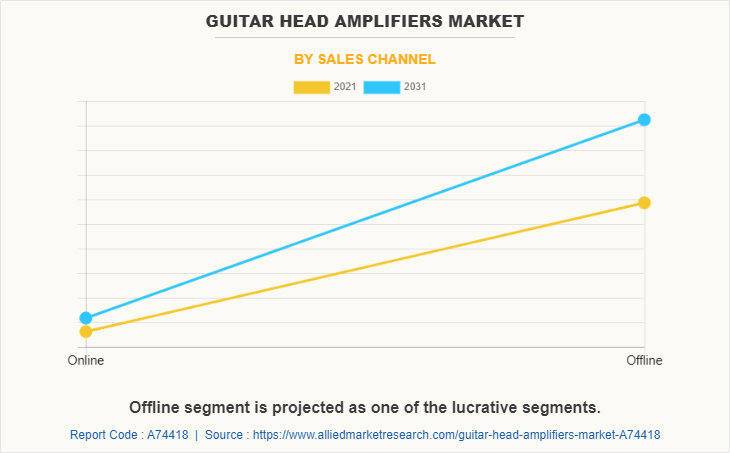
By application, the market is analyzed across household and commercial. In terms of market segmentation by application, the commercial segment holds the largest guitar head amplifiers market share in 2021, whereas the household segment is also expected to witness a higher growth rate during the forecast period. Digital connectivity options for integrating with other audio equipment, like mixing consoles and speaker systems, are becoming more and more common in commercial guitar head amplifier designs.
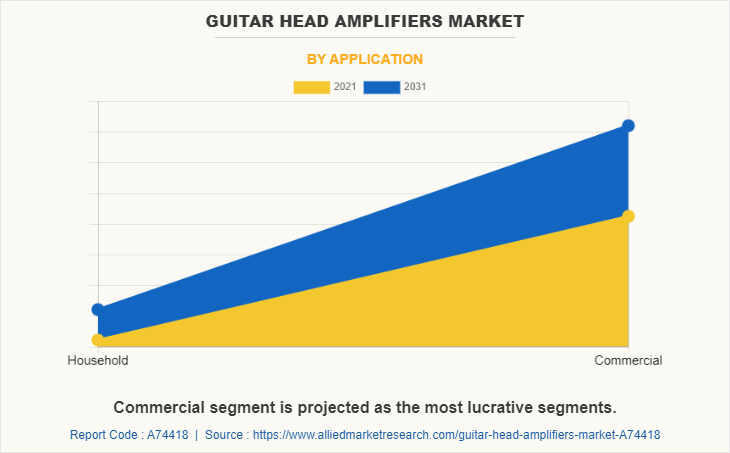
Region wise, the guitar heads amplifier market trends are analyzed across North America (the U.S., Canada, and Mexico), Europe (UK, Germany, France, and rest of Europe), Asia-Pacific (China, Japan, India, South Korea, and rest of Asia-Pacific), and LAMEA (Latin America, the Middle East, and Africa). In terms of market segmentation by region, the guitar head amplifiers market size was dominated by North America in 2021. North America is also expected to witness a higher growth rate during the forecast period. The North American market has increasingly embraced boutique amplifier manufacturers.
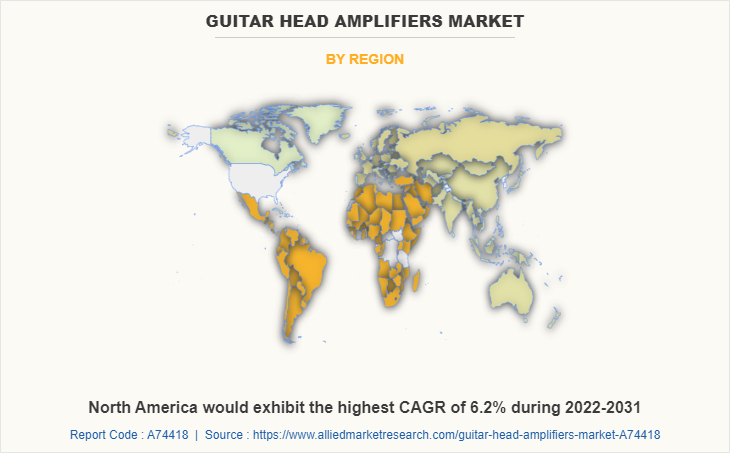
Key Developments/ Strategies
Innovations in technology and expanding demand for equalizers, especially in mini guitar amp heads, are the factors that drive the market. However, changing trends in the musical industry hamper the guitar head amplifiers market growth. Conversely, the advancement of digital technology in emerging markets is expected to create lucrative market opportunities.
The global guitar head amplifiers industry is highly competitive, owing to the strong presence of existing vendors. Vendors of guitar head amplifier market with extensive technical and financial resources are expected to gain a competitive advantage over their competitors because they can cater to market demands. The competitive environment in this market is expected to worsen as technological innovations, product extensions, and different strategies adopted by key vendors increase.
Fender Musical Instruments Corporation, Marshall Amplification, Blackstar Amplification Ltd., Hughes & Kettner, Orange Amps, Vox Amplification Ltd., Peavy Electronics, Roland Corporation, Laney Amplification, and PRS Guitars are the top companies holding a prime share in the guitar heads amplifier market. Top market players have adopted various strategies, such as product development, acquisition, innovation, partnership, and others, to expand their foothold in the guitar heads amplifier market.
- In July 2020, Peavey Gadgets and Audio Media Research (AMR) had consented to an arrangement under which AMR would obtain the ReValver guitar intensifier demonstrating software line from Peavey Hardware. AMR will introduce the ReValver line with an updated version of the flagship ReValver product and new ReValver additions that will once more introduce completely new guitar amp modeling software innovations to the market.
- In January 2023, Blackstar unveiled the Amped 2, a 100-watt guitar amp in a pedal format that features multi-effect, scalable power, USB and MIDI connectivity, and a range of power valve responses to make it feel and sound like a real tube amp.
- In April 2022, Vox presented two restricted release varieties of Vox's most well-known practice guitar amp, the all-simple Pathfinder 10. Both the Union Jack Royal Blue finish in Cream Brown and the Cream Brown finish in Union Jack Royal Blue have the recognizable, warm British sounds and iconic looks from Vox.
- In October 2022, PRS Guitars launched the HDRX 20 amplifier, which included two new designs, 50- and 100-watt amps centered around late 60’s British-inspired tone and a newly-documented “Authentic Hendrix” Touring Circuit – based on the same circuit in one of Hendrix’s personal amps, purportedly used at Woodstock.
- In January 2021, Gibson acquired Mesa/Boogie Amps, the latter being involved in manufacturing products under its name, and also will become “Gibson’s Custom Shop for Amplifiers.”
Competitive analysis
Competitive analysis and profiles of the major global guitar heads amplifier market players that have been provided in the report include Fender Musical Instruments Corporation, Marshall Amplification, Blackstar Amplification Ltd., Hughes & Kettner, Orange Amps, Vox Amplification Ltd., Peavy Electronics, Roland Corporation, Laney Amplification, and PRS Guitars.
Key Benefits for Stakeholders
- This report provides a quantitative analysis of the market segments, current trends, estimations, and dynamics of the guitar head amplifiers market from 2021 to 2031 to identify the prevailing guitar head amplifiers market opportunity.
- The market research is offered along with information related to key drivers, restraints, and opportunities.
- Porter's five forces analysis highlights the potency of buyers and suppliers to enable stakeholders to make profit-oriented business decisions and strengthen their supplier-buyer network.
- In-depth analysis of the guitar head amplifiers market outlook helps determine the prevailing guitar head amplifiers market opportunity.
- Major countries in each region are mapped according to their revenue contribution to the global market.
- Market player positioning facilitates benchmarking and provides a clear understanding of the present position of the market players.
- The report includes the analysis of the regional as well as global guitar head amplifiers market trends, key players, market segments, application areas, guitar head amplifiers market forecast, and market growth strategies.
Guitar Head Amplifiers Market Report Highlights
| Aspects | Details |
| Market Size By 2031 | USD 207.6 million |
| Growth Rate | CAGR of 5% |
| Forecast period | 2021 - 2031 |
| Report Pages | 250 |
| By Type |
|
| By Sales Channel |
|
| By Application |
|
| By Region |
|
| Key Market Players | Blackstar Amplification Ltd., Vox Amplification Ltd., Laney Amplification, Orange Amps, Yamaha Corporation, Roland Corporation, Marshall Amplification, PRS Guitars, Peavy Electronics, Fender Musical Instruments Corporation |
Analyst Review
The guitar head amplifiers market exhibited development potential across household and commercial sectors. Furthermore, the contribution to the worldwide market is predicted to grow considerably in the coming years. In addition, rise in adoption of wireless connectivity solutions is driving the growth of the guitar head amplifier market through digital transformation.
Guitar head amplifiers market is highly competitive, owing to strong presence of existing vendors. Guitar amplifier vendors are investing substantially in R&D and skilled workforce, and are anticipated to gain a competitive edge over their rivals. The competitive environment in this market is expected to further intensify with increase in technological innovations, product extensions, and different strategies adopted by key vendors.
The demand for guitar amplifiers in musical industry is estimated to expand at a rapid pace during the forecast period due to an increase in the quantity of several musical concerts and programmes worldwide.
The key players profiled in the report include Guitar Head Amplifiers market players, such as Fender Musical Instruments Corporation, Marshall Amplification, Blackstar Amplification Ltd., Hughes & Kettner, Orange Amps, Vox Amplification Ltd., Peavy Electronics, Roland Corporation, Laney Amplification, and PRS Guitars.
By application, the commercial segment holds the largest market share for Guitar Head Amplifiers Market.
North America holds the largest market share for Guitar Head Amplifiers market.
The Guitar Head Amplifiers Market was valued at $129.5 million in 2021, and is projected to reach $207.6 million by 2031, registering a CAGR of 4.95% from 2022 to 2031.
North America is projected to grow with the highest CAGR of 6.2%
The key players that operate in the market include Fender Musical Instruments Corporation, Marshall Amplification, Blackstar Amplification Ltd., Yamaha Corporation, Orange Amps, Vox Amplification Ltd., Peavy Electronics, Roland Corporation, Laney Amplification, and PRS Guitars.
Loading Table Of Content...
Loading Research Methodology...



